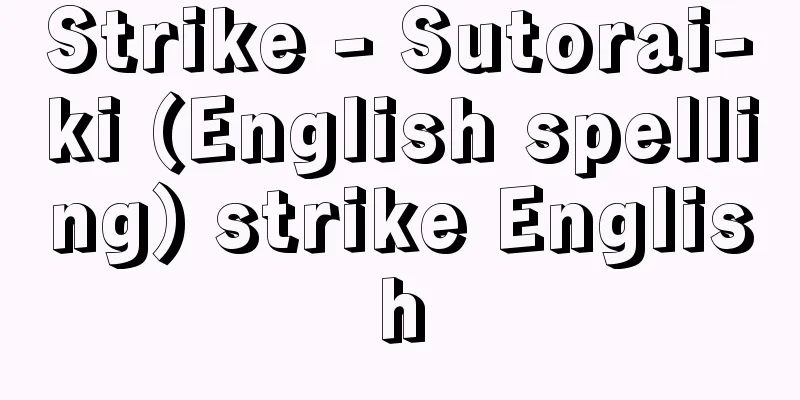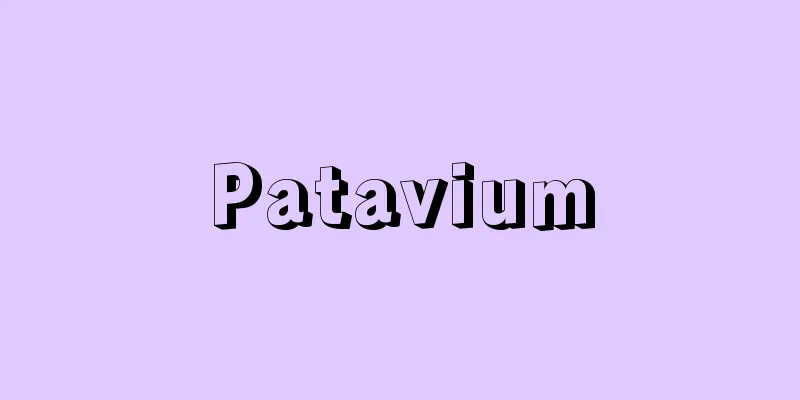Strike - Sutorai-ki (English spelling) strike English

|
It is one of the labor disputes in which workers unite and temporarily refuse to provide labor in order to get their demands met. It is often abbreviated to "strike." It can also be translated as "strike action" or "allied strike." In economics, it means a temporary halt to the sale of labor power products by workers. In response to this, employers take action such as a lockout (factory closure). Strikes are distinct from sabotage, which is the collective neglect of work. Also, vacation struggles and refusal to work overtime struggles are labor disputes that have a similar effect to strikes, but are not strikes. There are various types of strikes, depending on their objectives: economic strikes to achieve economic demands, political strikes for political demands, and sympathy strikes to support strikes by other workers. Also, depending on the range of workers participating, there are management strikes (full and partial strikes), regional strikes, national strikes, and international strikes. Regional and national strikes include general strikes. Depending on the nature of the strike, there are also distinctions such as unofficial strikes or wildcat strikes that are carried out independently by ordinary union members without the approval of the union headquarters, time-limited strikes, surprise strikes, and wave strikes. In a capitalist society, workers have no way of making a living except by selling their labor power as a commodity. The labor power commodity cannot be stored, and under the pressure of a total surplus population, workers are at a decisive disadvantage when entering into a contract for the purchase and sale of labor power with capitalists (managers), i.e., an employment or labor contract. To cover this disadvantage, workers, who are economically weak, have formed labor unions and begun to organize and fight through strikes as a weapon to get their demands across. [Seiichiro Hayakawa] foreign countryThe history of strikes is as old as the history of wage labor and the emergence of labor unions. However, it was only after the Industrial Revolution, when capitalist production relations were established, that strikes acquired a social significance. Strikes are the most important and effective weapon used by workers in dispute actions, and are inextricably linked to the right to collective bargaining, and they have become an important catalyst for the promotion of labor union movements. One of the historic strikes of the 19th century is the Eight-Hour Work Strike in the United States on May 1, 1886. Strikes demanding an eight-hour work day that began with workers in Chicago spread to other areas and were the direct catalyst for the first International May Day in 1890. The 1889 strike by London dockworkers was not carried out by craft unions organized by skilled workers, but was a major strike by unskilled workers, and this strike sparked the organization of unskilled workers and the birth of general unions. In the 20th century, in addition to general unions, industrial unions were organized, focusing on the new key workers in large machine factories. Strikes sometimes became large-scale in response to political and economic circumstances, and political strikes appeared that influenced the entire political situation of a country, sometimes developing into general strikes. The general strikes during the Russian Revolution in 1905 and 1917 were truly politically revolutionary, and while the former was suppressed, the latter was linked to an armed uprising and contributed to the establishment of a revolutionary government. The general strike against fascism in France in 1934 led to the establishment of a Popular Front government. Other notable strikes, although neither of which achieved their purpose, include the Swedish general strike of 1909 and the general strike centered on British coal miners in 1926. In the United States, a three-and-a-half-month strike by steel workers in 1919 led to the abolition of the 12-hour workday, although it ended in defeat. Immediately after the Second World War, strikes broke out in many countries, but as the postwar system entered a period of relative stability, the number of strikes decreased. However, there are large differences between countries. In the United States, strikes centered on demands for wage increases increased sharply immediately after the war, but decreased thereafter. A new feature of the postwar period is the increase in strikes by white-collar workers and public sector workers such as civil servants. Major strikes after the war include the May strike in France in 1968 and the strikes in Italy from 1968 to 1969 centered on pension issues, both of which influenced the course of government. The British coal mining strike of 1984 to 1985 was held in opposition to the closure of coal mines, and was a head-on confrontation with the Thatcher Conservative government of the time, and lasted a year, becoming the longest strike in the history of the British labor movement. However, overall, the propensity (frequency) of strikes has been on a downward trend since the 1980s. However, there are many cases of large-scale strikes occurring in different countries, such as the strikes in Greece in 2010, which were triggered by a financial crisis. [Seiichiro Hayakawa] JapanIn Japan, strikes (united strikes) occurred during the Meiji period with the rise of Japanese capitalism, but they were still sporadic. Moreover, the enactment of the Public Order Police Law in 1900 (Meiji 33) led to the complete suppression of the social labor movement itself. After World War I, as Japanese capitalism developed and heavy industry progressed, strikes occurred one after another in the heavy industry sector, such as steel and shipbuilding, but the suppression of labor movements was severe, and most strikes were suppressed with the police being called in. After the Second World War, basic labor rights such as the right to organize, the right to collective bargaining, and the right to strike were legally guaranteed, and labor unions were formed one after another. Then, amid the economic turmoil and hardships following the defeat, strikes increased dramatically. In 1947 (Showa 22), the February 1st General Strike was almost carried out, but was aborted when the American Occupation Forces ordered it to be called off. After 1948, the American Occupation Forces' policy towards Japan changed, and the tendency to suppress labor movements intensified. In July of that year, the MacArthur Letter and Cabinet Order No. 201 significantly restricted the basic labor rights of public sector workers, and denied the right to collective bargaining and the right to strike. After this, strikes decreased dramatically. After the formation of the Sohyo (General Council of Japanese Trade Unions) in 1950, a struggle against the Subversive Activities Prevention Law (Anti-Subversive Activities Law) was launched in 1952, and so-called labor struggle strikes (political strikes) were carried out. With the start of rapid economic growth in 1955, spring labor offensives were held every year, with strikes mainly demanding wage increases. Of these, the pension strike of 1973, which demanded an indexation system for pensions based on inflation, is particularly noteworthy. As for political strikes, there was the 1960 strike against the revision of the Japan-US Security Treaty, mainly by JNR workers. In 1975, a strike to restore the right to strike was held, mainly by workers in public services and state-run enterprises such as JNR and Japan Post, but it ended without achieving any concrete results. Since the 1980s, industrial action, especially strikes, has declined significantly. The decline in the propensity (frequency) of strikes among labor unions in large private companies is particularly notable. Even in international comparison, Japan is ranked among the OECD (Organization for Economic Cooperation and Development) countries that rarely engage in strikes. [Seiichiro Hayakawa] Restrictions on basic labor rights and the right to strikeFundamental labor rights (the right to organize, the right to collective bargaining, and the right to strike, among other things) were severely restricted in every country in the early stages of capitalist development. However, since the Industrial Revolution, there has historically been a gradual trend toward greater acceptance of fundamental labor rights. Currently, many developed capitalist countries have legislation that prohibits strikes for public servants and restricts strikes in times of emergency, but in many countries these restrictions have become hollow. In prewar Japan, workers' fundamental labor rights were never legally guaranteed. All labor movements were subject to repression and crackdowns. It was after World War II that fundamental labor rights were legally recognized in Japan. Article 28 of the Japanese Constitution, which states, "The right of workers to organize and to bargain collectively and to other collective actions is guaranteed," became the ultimate legal basis. Thus, fundamental labor rights, including the right to strike, were guaranteed to all workers. However, following the MacArthur Letter and Cabinet Order No. 201 of July 1948, the right to collective bargaining and the right to strike were denied to public sector workers, and this remains the case to this day. Since then, the restoration of the right to strike, especially the right to strike, has remained an issue to this day. In November 2002, the ILO (International Labour Organization) Governing Body, in response to a lawsuit filed by RENGO (Japanese Trade Union Confederation) and Zenroren (National Trade Union Confederation), pointed out that restrictions on fundamental labour rights in Japan's public sector violate ILO Conventions No. 87 and No. 98, and made groundbreaking recommendations calling for improvements. Following the ILO's criticism, the issue became a topic for domestic consideration, but the current state of the discussion is still far from a complete restoration of fundamental labour rights. [Seiichiro Hayakawa] "The Story of Japanese Labor Unions," by Okawachi Kazuo and Matsuo Hiroshi, 5 volumes (1965-1973, Chikuma Shobo)" ▽ "The History and Theory of Strikes," by Fujimoto Takeshi (1994, Shin Nihon Shuppansha)" ▽ "The Story of Postwar Labor Movement History Publishing Committee (ed.), 10 volumes (1997-2000, Education and Culture Association)" ▽ "100 Years of Japanese Labor Unions," edited by Ohara Institute for Social Research, Hosei University (1999, Junposha)" ▽ "The Western Civil Service System and the Japanese Civil Service System," edited and published by the Japan ILO Association (2003)" ▽ "Compilation of Documents on the Japanese Labor Movement," 14 volumes (2005-2007, Junposha)" ▽ "Yearly editions of the Japanese Labor Yearbook, edited by Ohara Institute for Social Research, Hosei University (Shunposha)" [References] | | | | | | | | | | | |Source: Shogakukan Encyclopedia Nipponica About Encyclopedia Nipponica Information | Legend |
|
労働者の争議行為の一つであり、労働者が自分たちの要求を通すために、団結して一時的に労働の提供を拒否することをいう。ストと省略されることも多い。罷業あるいは同盟罷業とも訳される。経済学的には、労働者の行う労働力商品の一時的な売り止め行為を意味する。これに対抗するものとして、使用者の行うのがロックアウト(工場閉鎖)である。ストライキは、集団的に作業を怠るサボタージュ(怠業)とは区別される。また休暇闘争や残業拒否闘争などは、スト類似効果のある争議行為ではあってもストライキではない。 ストライキの種類には、その目的に応じ、経済的な諸要求を通そうとする経済ストと、政治的諸要求のための政治スト、他の労働者のストを支援するための同情ストがある。また、参加労働者の範囲の広狭に応じて、経営スト(全部ストと部分スト)、地域スト、全国スト、国際スト等がある。地域スト、全国ストにはゼネラル・ストライキ(ゼネスト)が含まれる。その他の態様に応じ、組合本部の承認なしに一般組合員が独自に行う非公認ストまたは山猫スト、さらに時限スト、抜き打ちスト、波状ストなどの区別がある。 資本主義社会では、原則として労働者は自らの労働力を商品として売る以外に生活の術(すべ)はない。労働力商品は貯蔵ができず、しかも総体的過剰人口の圧力を受けて、労働者は資本家(経営者)との労働力商品の売買契約=雇用・労働契約の締結に際し、決定的に不利な立場にたつ。経済的弱者としての労働者は、その不利をカバーするために労働組合を結成し、自分たちの要求を通すための武器としてストライキを組織して闘うようになった。 [早川征一郎] 外国ストライキの歴史は、賃金労働および労働組合の発生の歴史とともに古い。だが、それが社会的存在意義をもつに至ったのは、資本主義的生産関係が確立した産業革命以後である。ストライキは、争議行為における労働者のもっとも重要かつ効果的な武器としての意義をもち、団体交渉権と表裏一体をなし、労働組合運動推進の重要な契機となった。 19世紀の歴史的なストライキとしては、1886年5月1日のアメリカにおける8時間労働ストがあげられる。シカゴの労働者に端を発した8時間労働日を要求するストは各地に波及し、1890年に第1回国際メーデーが開始される直接のきっかけとなった。1889年のロンドンのドック労働者のストライキは、熟練労働者によって組織されるクラフト・ユニオンによるものではなく、不熟練労働者による大ストライキであり、このストライキを契機に不熟練労働者の組織化が進み、一般組合が誕生した。 20世紀に入り、一般組合のほか、機械制大工場における新しい基幹工を中心にした産業別組合が組織化された。ストライキは政治経済的諸状況に対応して、ときに大規模化し、また一国の政治状況全体を左右する政治的ストライキが出現し、ときにゼネラル・ストライキに発展した。1905年および1917年のロシア革命におけるゼネストは、まさに政治的革命的様相を示し、前者は弾圧されたが、後者は武装蜂起(ほうき)に連動して革命政権の樹立に貢献した。1934年のフランスにおけるファシズムに反対するゼネストは、人民戦線政府の成立を導いた。このほか、ともに目的を達しなかったが、1909年のスウェーデンのゼネスト、1926年のイギリス炭鉱労働者を中心としたゼネストなどが特筆される。アメリカでは、1919年に鉄鋼労働者の3か月半のストライキが行われ、敗北に終わったとはいえ12時間労働の廃止を実現した。 第二次世界大戦直後は多くの国でストライキが勃発(ぼっぱつ)したが、戦後体制が相対的安定期に入るとともに、ストライキは減少した。ただし、国により違いが大きい。アメリカでは、戦争直後は賃上げ要求を中心とするストが急増したが、その後は減少した。なお、戦後の新しい特徴として、ホワイトカラー労働者と公務員など公共部門の労働者のストライキが増えたことがあげられる。戦後の大きなストライキとしては、1968年のフランスの5月ストライキ、1968~1969年のイタリアにおける年金問題などを中心とするストライキがあり、ともに政権の行方を左右した。1984~1985年のイギリス炭鉱ストライキは、炭鉱閉鎖に反対して行われ、時のサッチャー保守党政権とまっこうから対決し、1年に及ぶイギリス労働運動史上最長のストライキとなった。ただ、全体として、1980年代以降、スト性向(頻度)は低下傾向にある。もっとも、2010年、財政危機に端を発したギリシアのストライキのように、国により大規模なストライキが発生している事例は数多い。 [早川征一郎] 日本日本では、明治期、日本資本主義の勃興とともに、ストライキ(同盟罷業)が発生したが、まだ散発的であった。しかも1900年(明治33)、治安警察法が制定されたことにより、社会労働運動自体がことごとく弾圧された。第一次世界大戦後、日本資本主義が発展して重工業化が進むにつれ、鉄鋼、造船など重工業部門でのストライキが続出したが、労働運動への弾圧が厳しく、ほとんどのストが警察の出動を伴い鎮圧された。 第二次世界大戦後、団結権、団体交渉権、争議権といった労働基本権が法的に保障されたため、労働組合が相次いで結成された。そして敗戦後の経済的混乱と生活難のなかで、ストライキが激増した。1947年(昭和22)には、二・一ゼネストが行われる寸前にまで至ったが、アメリカ占領軍の中止命令によって未遂に終わった。1948年以降、アメリカ占領軍の対日政策が変化したことにより、労働運動への抑圧傾向が強まった。この年7月のマッカーサー書簡・政令二〇一号によって、官公労働者の労働基本権は大幅に制限され、団体交渉権、争議権が否認された。このあと、ストライキは激減した。1950年の総評(日本労働組合総評議会)結成のあと、1952年には破防法(破壊活動防止法)反対闘争が展開され、いわゆる労闘スト(政治スト)が行われた。 1955年、高度経済成長の開始とともに、春闘が毎年展開され、賃上げ要求を中心にストライキが行われた。そのなかでも、年金の物価スライド制を要求した1973年の年金ストが特筆される。政治ストとしては、国鉄労働者を中心した1960年の日米安保条約改定反対ストが行われた。1975年には、国鉄・郵政など公務・国営企業の労働者を中心としたスト権回復ストが行われたが、具体的な成果を得られないままで終わった。 1980年代以降、争議行為、とくにストライキは目だって減少した。とりわけ民間大企業労組におけるスト性向(頻度)の低下が顕著である。国際的に比較しても、OECD(経済協力開発機構)諸国のなかで、日本はほとんどストを行わない国のランクに入っている。 [早川征一郎] 労働基本権、ストライキ権の制限労働基本権(団結権、団体交渉権、ストライキ権を中心とする争議権)は、資本主義の発展の初期には、いずれの国においても厳しく制限された。だが、産業革命期以降、労働基本権は歴史的にはしだいに容認される傾向を示した。現在、先進資本主義諸国では、公務員についてはストを禁止し、緊急事態に際してはストを制限する立法をもつ国は少なくないが、その制限は空洞化している国も多い。 戦前の日本で、労働者の労働基本権が法的に保障されたことはなかった。労働運動はすべて抑圧と取締りの対象であった。日本で、労働基本権が法的に容認されたのは第二次世界大戦後であった。日本国憲法第28条の「勤労者の団結する権利及び団体交渉その他の団体行動をする権利は、これを保障する。」という規定が最高の法的根拠となった。こうして、すべての労働者に、ストライキ権を含む労働基本権が保障された。だが、1948年7月のマッカーサー書簡・政令二〇一号を契機に、公務労働者の団体交渉権および争議権は否認され、今日に至っている。それ以後、争議権とりわけストライキ権の回復が課題として今日まで引き続いている。 2002年11月、ILO(国際労働機関)理事会は、連合(日本労働組合総連合会)および全労連(全国労働組合総連合)の提訴を受けるかたちで、日本の公務部門における労働基本権制約は、ILO87号条約および98号条約に違反する旨を指摘し、その改善を促す画期的な勧告を行った。ILOの指摘を受けて、問題は国内検討課題となったが、議論の現状は労働基本権の全面回復にはほど遠いのが実状である。 [早川征一郎] 『大河内一男・松尾洋著『日本労働組合物語』全5巻(1965~1973・筑摩書房)』▽『藤本武著『ストライキの歴史と理論』(1994・新日本出版社)』▽『ものがたり戦後労働運動史刊行委員会編『ものがたり戦後労働運動史』全10巻(1997~2000・教育文化協会)』▽『法政大学大原社会問題研究所編『日本の労働組合100年』(1999・旬報社)』▽『財団法人日本ILO協会編・刊『欧米の公務員制度と日本の公務員制度』(2003)』▽『法政大学大原社会問題研究所編『日本労働運動資料集成』全14巻(2005~2007・旬報社)』▽『法政大学大原社会問題研究所編『日本労働年鑑』各年版(旬報社)』 [参照項目] | | | | | | | | | | | |出典 小学館 日本大百科全書(ニッポニカ)日本大百科全書(ニッポニカ)について 情報 | 凡例 |
Recommend
Extremely inferior midline - Kyokukaseichu
…It is also called the polar midline, or simply t...
Riverside [town] - Kawahara
A former town in the northern part of Yazu Distric...
Real Estate - Fudosan
Land and its fixtures (Civil Code, Article 86, Pa...
Yifan - Yifan
...The Lord of the Land is the guardian deity of ...
《Positivismus und Idealismus in der Sprachwissenschaft》 (English notation)Positivismus und IdealismusinderSprachwissenschaft
…For him, language is nothing but an expression o...
peptide
When the α-carboxyl group of one amino acid and t...
Nippara Limestone Cave - Nippara Limestone Cave
This limestone cave is located in the Ogawadani v...
Isabella d'Este - Isabella d'Este
…He also employed A. Mantegna as his court painte...
AFL - AFL
Abbreviation for American Federation of Labor. A n...
Sealing wax
A waxy substance used to seal containers, document...
Adaka style pottery - Adaka style pottery
...This is an inland bay shell mound where agemak...
Onga [town] - Onga
A town in Onga County, in the northern part of Fuk...
The Easy Way - Gaku no Michi
...This work is in the Post-Webern style, but he ...
Hikami Shikeshimaro - Hikami Shikeshimaro
Years of birth: unknown. An aristocrat from the Na...
Statistical estimation
A method of mathematical statistics for quantitati...








![Obama [city] - Obama](/upload/images/67cb2164f19b8.webp)
